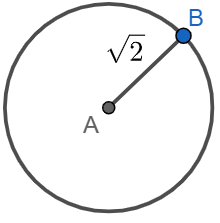
How do you write a polar equation for the circle centred at the origin with radius$\sqrt{2}$.
Answer
546.3k+ views
Hint: We will use the concept of the circle equation to solve the above question. We know that the general equation of the circle which is centred at the origin is given by equation ${{x}^{2}}+{{y}^{2}}={{r}^{2}}$, where r is the radius of the circle. And, to write the equation in polar form we replace $x$ by $r\cos \theta $ and $y$ by $r\sin \theta $, where $\theta $ is the angle made by the radius of the circle form x-axis.
Complete step by step answer:
We know that the general equation of the circle which is centred at the origin and has radius ‘r’ is given as ${{x}^{2}}+{{y}^{2}}={{r}^{2}}$.
Since we know from the question that we have to write an equation of the circle which is centred at origin and radius is $\sqrt{2}$.
So, we can write equation of circle as:
${{x}^{2}}+{{y}^{2}}={{\left( \sqrt{2} \right)}^{2}}$
$\Rightarrow {{x}^{2}}+{{y}^{2}}=2$
Hence, the equation of circle which is centred at origin and has radius $\sqrt{2}$ is given as ${{x}^{2}}+{{y}^{2}}=2$.
Now, to convert the given equation in polar form we will replace $x$ by $r\cos \theta $ and $y$ by $r\sin \theta $, where $\theta $ is the angle made by any radius of the circle form x-axis.
So, to convert the equation of the circle ${{x}^{2}}+{{y}^{2}}=2$ into polar form we will replace $x$ by $\sqrt{2}\cos \theta $ and $y$ by $\sqrt{2}\sin \theta $, where $\theta $ is the angle made by the radius of circle form x-axis.
Thus, we will get:
$\Rightarrow {{\left( r\cos \theta \right)}^{2}}+{{\left( r\sin \theta \right)}^{2}}=2$
$\Rightarrow {{r}^{2}}{{\cos }^{2}}\theta +{{r}^{2}}{{\sin }^{2}}\theta =2$
Now, we will divide both sides of the equation by 2 then, we will get:
$\Rightarrow {{r}^{2}}\left( {{\cos }^{2}}\theta +{{\sin }^{2}}\theta \right)=2$
Now, from trigonometric identity we know that ${{\cos }^{2}}\theta +{{\sin }^{2}}\theta =1$
$\Rightarrow {{r}^{2}}\times 1=2$
$\Rightarrow {{r}^{2}}=2$

Hence, ${{r}^{2}}=2$ is the polar equation for the circle centred at the origin with radius$\sqrt{2}$.
This is our required solution.
Note:
Students are required to note that general equation of the circle which is centred at point other than origin and let that point is $\left( a,b \right)$ and $r$ be the radius of the given circle is given by ${{\left( x-a \right)}^{2}}+{{\left( y-b \right)}^{2}}={{r}^{2}}$.
Complete step by step answer:
We know that the general equation of the circle which is centred at the origin and has radius ‘r’ is given as ${{x}^{2}}+{{y}^{2}}={{r}^{2}}$.
Since we know from the question that we have to write an equation of the circle which is centred at origin and radius is $\sqrt{2}$.
So, we can write equation of circle as:
${{x}^{2}}+{{y}^{2}}={{\left( \sqrt{2} \right)}^{2}}$
$\Rightarrow {{x}^{2}}+{{y}^{2}}=2$
Hence, the equation of circle which is centred at origin and has radius $\sqrt{2}$ is given as ${{x}^{2}}+{{y}^{2}}=2$.
Now, to convert the given equation in polar form we will replace $x$ by $r\cos \theta $ and $y$ by $r\sin \theta $, where $\theta $ is the angle made by any radius of the circle form x-axis.
So, to convert the equation of the circle ${{x}^{2}}+{{y}^{2}}=2$ into polar form we will replace $x$ by $\sqrt{2}\cos \theta $ and $y$ by $\sqrt{2}\sin \theta $, where $\theta $ is the angle made by the radius of circle form x-axis.
Thus, we will get:
$\Rightarrow {{\left( r\cos \theta \right)}^{2}}+{{\left( r\sin \theta \right)}^{2}}=2$
$\Rightarrow {{r}^{2}}{{\cos }^{2}}\theta +{{r}^{2}}{{\sin }^{2}}\theta =2$
Now, we will divide both sides of the equation by 2 then, we will get:
$\Rightarrow {{r}^{2}}\left( {{\cos }^{2}}\theta +{{\sin }^{2}}\theta \right)=2$
Now, from trigonometric identity we know that ${{\cos }^{2}}\theta +{{\sin }^{2}}\theta =1$
$\Rightarrow {{r}^{2}}\times 1=2$
$\Rightarrow {{r}^{2}}=2$

Hence, ${{r}^{2}}=2$ is the polar equation for the circle centred at the origin with radius$\sqrt{2}$.
This is our required solution.
Note:
Students are required to note that general equation of the circle which is centred at point other than origin and let that point is $\left( a,b \right)$ and $r$ be the radius of the given circle is given by ${{\left( x-a \right)}^{2}}+{{\left( y-b \right)}^{2}}={{r}^{2}}$.
Recently Updated Pages
Master Class 10 General Knowledge: Engaging Questions & Answers for Success

Master Class 10 Computer Science: Engaging Questions & Answers for Success

Master Class 10 English: Engaging Questions & Answers for Success

Master Class 10 Social Science: Engaging Questions & Answers for Success

Master Class 10 Maths: Engaging Questions & Answers for Success

Master Class 10 Science: Engaging Questions & Answers for Success

Trending doubts
The shortest day of the year in India

Why is there a time difference of about 5 hours between class 10 social science CBSE

Write a letter to the principal requesting him to grant class 10 english CBSE

What is the median of the first 10 natural numbers class 10 maths CBSE

The Equation xxx + 2 is Satisfied when x is Equal to Class 10 Maths

State and prove converse of BPT Basic Proportionality class 10 maths CBSE




